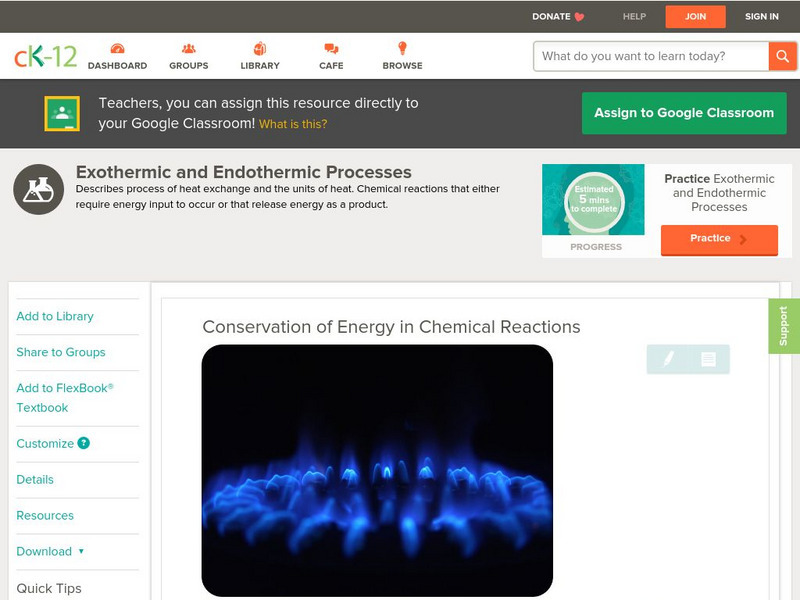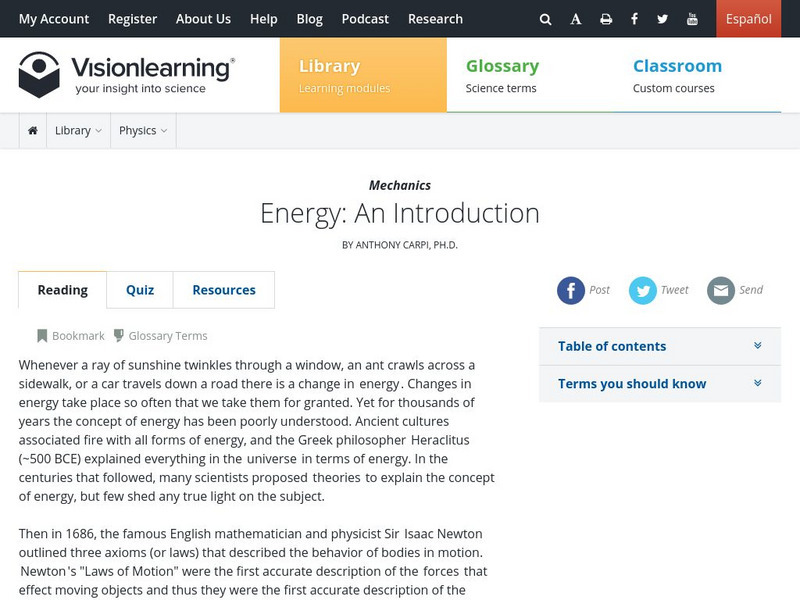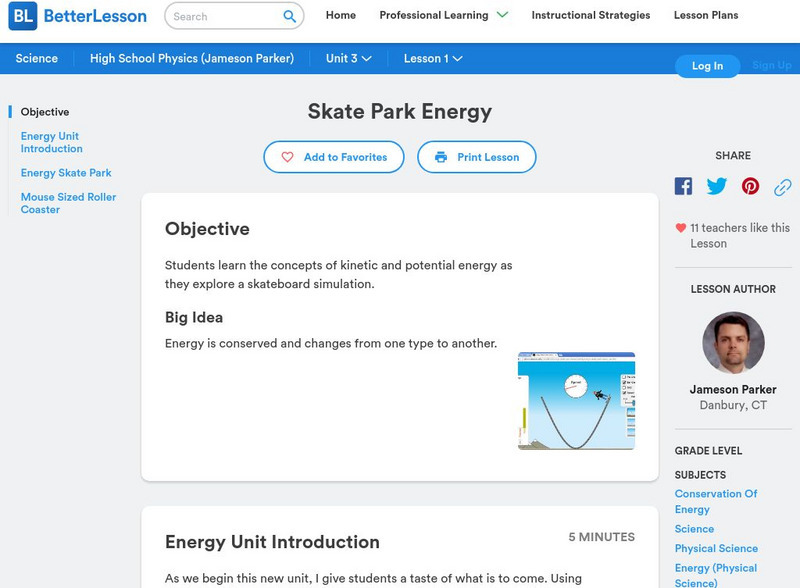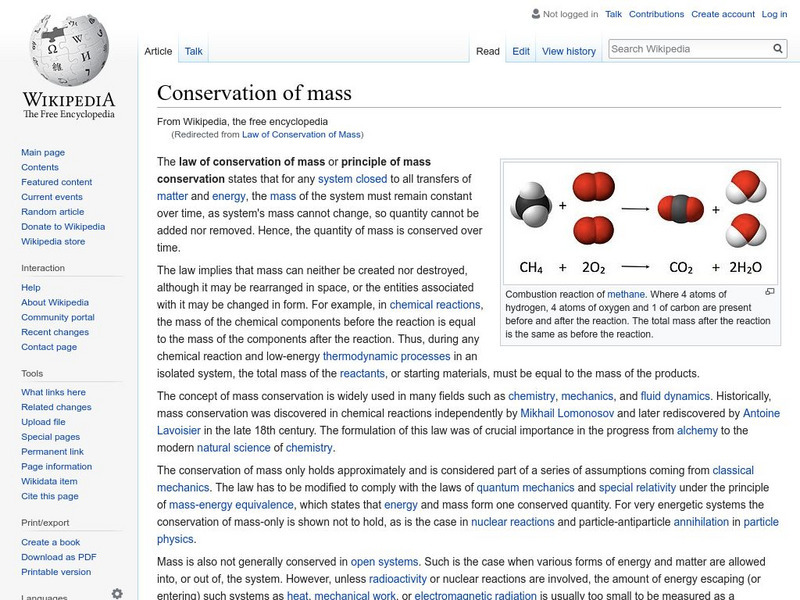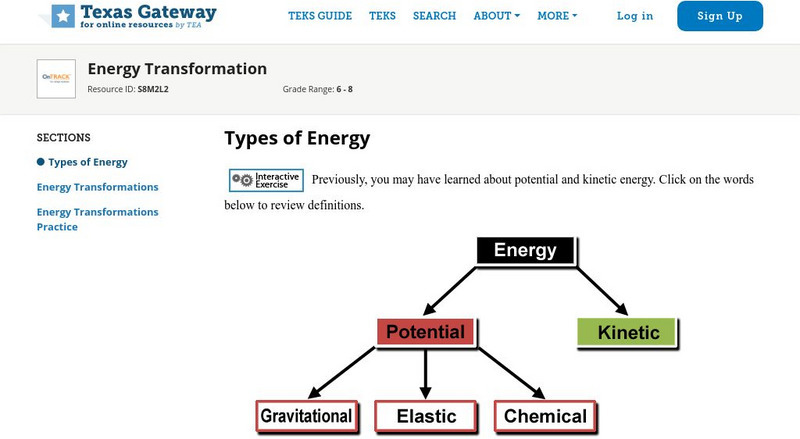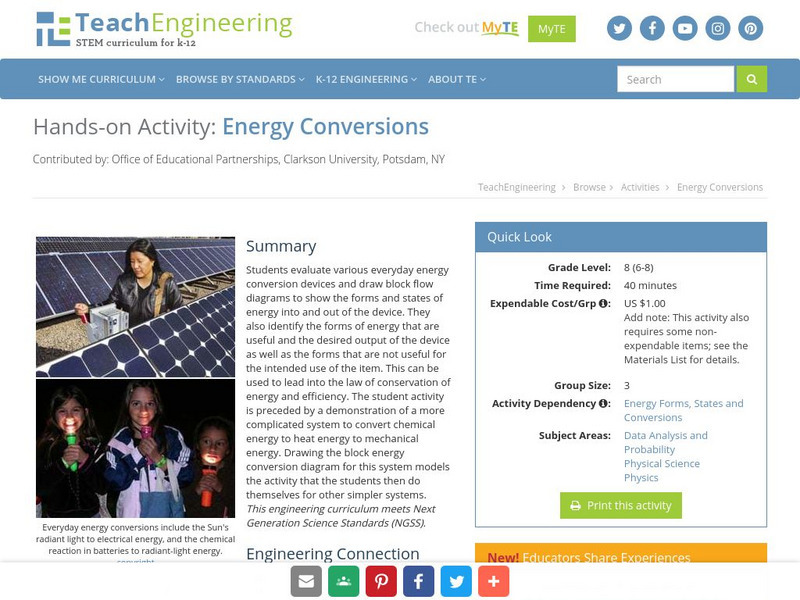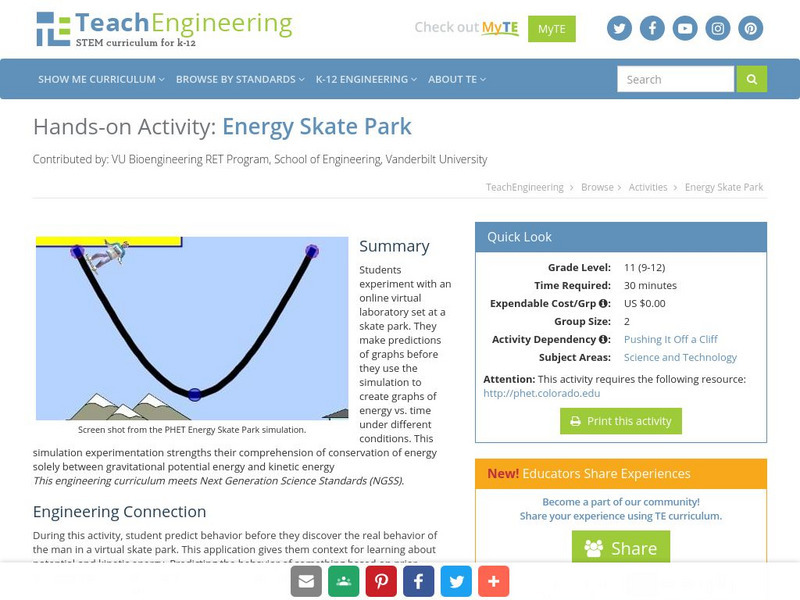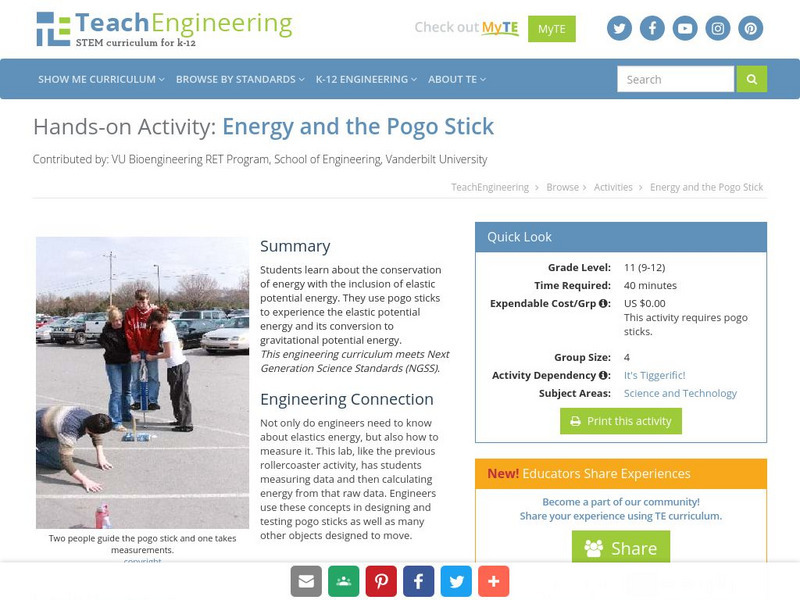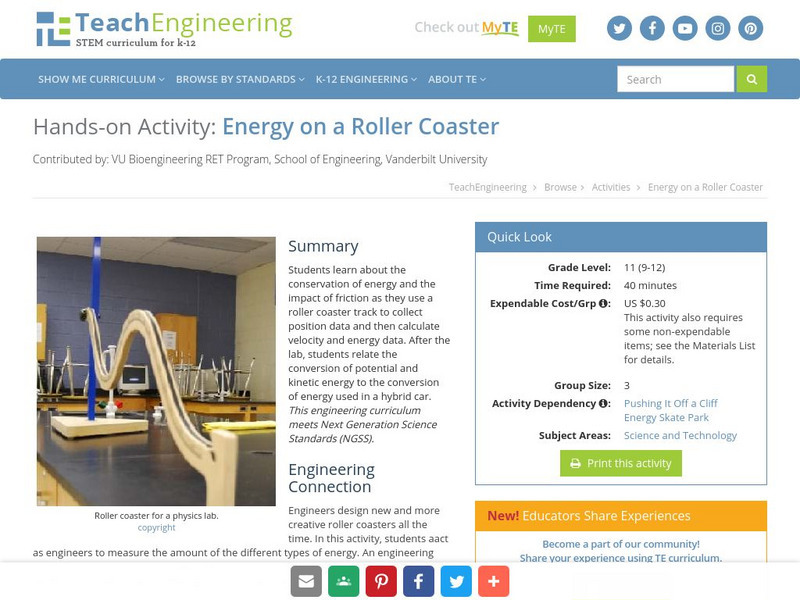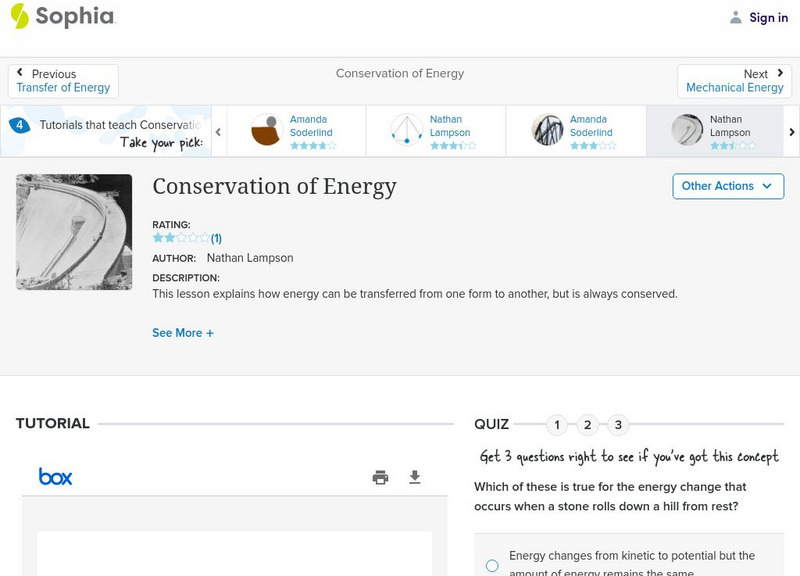Hi, what do you want to do?
CK-12 Foundation
Ck 12: Physical Science: Conservation of Energy in Chemical Reactions
[Free Registration/Login may be required to access all resource tools.] Describes the law of conservation of energy and how energy is conserved in chemical reactions.
CK-12 Foundation
Ck 12: Physical Science: Conservation of Energy in Chemical Reactions
[Free Registration/Login may be required to access all resource tools.] Covers the law of conservation of energy and how energy is conserved in chemical reactions.
Texas Instruments
Texas Instruments: Conservation of Energy
This activity assesses students' knowledge and understanding of conservation of energy.
Vision Learning
Visionlearning: General Science: Energy: An Introduction
Instructional module focusing on energy. Discussion includes forms of energy, conservation of energy, and the laws of thermodynamics. Site also includes an interactive practice quiz and links relating to the topic.
Better Lesson
Better Lesson: Skate Park Energy
Using computer simulation, students will explore the concept of conservation of energy at a skate park. After the completion of that exercise, students will move to a worksheet about the concepts with a roller coaster. Site includes...
CK-12 Foundation
Ck 12: Conservation of Energy
[Free Registration/Login may be required to access all resource tools.] Students investigate how all types of energy, including work, relate to each other and are conserved in a closed system.
Georgia State University
Georgia State University: Hyper Physics: Conservation of Energy
This site is from the Physics Department at Georgia State University. The conservation of energy as a fundamental conservation law is presented and compared to other conservation laws (momentum and angular momentum). Links to further...
Georgia State University
Georgia State University: Hyper Physics: Conservation of Energy as a Fundamental Principle
See how this principle translates in to fluids and the Bernoulli equation as well as into electric circuits and the voltage law and finally into heat and thermodynamics through the first law of thermodynamics.
Mocomi & Anibrain Digital Technologies
Mocomi: Law of Conservation of Energy
Where does energy come from? How is it sustained? What does the Law of Conservation of Energy do? Find out!
Texas Education Agency
Texas Gateway: Law of Conservation of Energy: Heat Transfer
Given illustrations, scenarios, descriptions, and/or diagrams, students will demonstrate understanding of heat transfer.
Wikimedia
Wikipedia: Conservation of Mass
This site from Wilkopedia defines the law of conservation of mass. Included are links to related topics and terms used in the definition.
Texas Education Agency
Texas Gateway: Rotational Kinetic Energy: Work and Energy Revisited
By the end of this section, you will be able to derive the equation for rotational work, calculate rotational kinetic energy, and demonstrate the law of conservation of energy.
University of Colorado
University of Colorado: Ph Et Interactive Simulations: Pendulum Lab
An interactive simulation that teaches about periodic motion, simple harmonic motion, and conservation of energy. Observe one or two pendulums to determine how the swing is influenced by the length of the string, the mass of the pendulum...
CK-12 Foundation
Ck 12: Conservation of Mass and Energy in Nuclear Reactions
[Free Registration/Login may be required to access all resource tools.] Explores the conservation of mass and energy in nuclear reactions and Einstein's equation.
Texas Education Agency
Texas Gateway: Types of Energy
This interactive tutorial provides a brief review of the 2 types of energy and an explanation of the law of of conservation of energy.
TeachEngineering
Teach Engineering: Energy Conversions
Students evaluate various everyday energy conversion devices and draw block flow diagrams to show the forms and states of energy into and out of the device. They also identify the forms of energy that are useful and the desired output of...
TeachEngineering
Teach Engineering: Energy Skate Park
This activity focuses on the conservation of energy solely between gravitational potential energy and kinetic energy. Students work with a virtual laboratory set at a skate park. They make predictions of graphs before they use the...
TeachEngineering
Teach Engineering: Energy and the Pogo Stick
This activity utilizes hands on learning with the conservation of energy with the inclusion of elastic potential energy. Students use pogo sticks to experience the elastic potential energy and its conversion to gravitational potential...
TeachEngineering
Teach Engineering: Energy Transfer in Musical Instruments
This lesson covers concepts of energy and energy transfer utilizing energy transfer in musical instruments as an example. More specifically, the lesson explains the two different ways in which energy can be transferred between a system...
TeachEngineering
Teach Engineering: Energy on a Roller Coaster
This activity utilizes hands-on learning with the conservation of energy and the interaction of friction. Students use a roller coaster track and collect position data. The students then calculate velocity, and energy data. After the...
TeachEngineering
Teach Engineering: From Sunlight to Electric Current
The lesson will first explore the concept of current in electrical circuits. Current will be defined as the flow of electrons. Photovoltaic (PV) cell properties will then be introduced. This will lead to the principle of "Conservation of...
University of Colorado
University of Colorado: Ph Et Interactive Simulations: Masses & Springs
An interactive simulation that teaches about springs, Hooke's Law, and conservation of energy observing changes in kinetic, potential, and thermal energy by adjusting the stiffness and damping of springs holding various masses. This...
Sophia Learning
Sophia: Conservation of Energy: Lesson 2
This lesson explains how energy can be transferred from one form to another, but is always conserved. It is 2 of 4 in the series titled "Conservation of Energy."
Sophia Learning
Sophia: Conservation of Energy: Lesson 4
This lesson explains how energy can be transferred from one form to another, but is always conserved. It is 4 of 4 in the series titled "Conservation of Energy."






